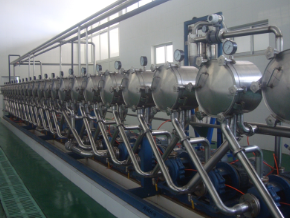The main uses of wheat are for making food and processing starch. In recent years, approximately 800,000 tons of wheat starch are produced annually in the world. Australian countries produce 200,000 tons, and North American and Asian countries produce about 300,000 tons. The annual world production of gluten or dry gluten and protein concentrates is approximately 150,000 tons.
There is no special standard for wheat flour for starch in our country, but production has proved that the flour used for starch production is equivalent to the special second-class flour in all-purpose flour. From an economic point of view, the higher the gluten content, the higher the profit of starch production. This is because two main products can be obtained in starch production, namely starch and gluten (gluten flour). Among them, gluten flour The value is several times that of wheat starch.
Starch washing
The underflow separated by the three-phase decanter centrifuge is usually diluted with process water and then sent to a centrifugal screen for treatment to remove residual fibers. Then it enters multi-stage cyclone washing, usually using a 12-stage starch washing cyclone. The underflow also contains some small B-starches, pentosan and fine fibers. In order to better separate them, this process uses a vertical high-speed three-phase disc nozzle centrifuge placed in front of the cyclone group. Used in conjunction with the cyclone group, it ensures efficient and thorough starch washing.
gluten collection
The underflow and overflow from the three-phase decanter centrifuge are processed by screens respectively to recover more gluten that can form clumps. The recovered gluten is processed together with the medium phase in the process, and the wet gluten obtained is further dehydrated and dried to make gluten powder.
by-product
The pentosan in the overflow can be directly used as feed in the liquid state, or the solid part can be separated after adding enzyme reaction; the liquid part is concentrated together with the process wastewater, and then dried together with fibers and used as feed.
Fiber screening process
The crude starch milk obtained from the bottom of the decanter is a mixture containing a small amount of fiber and protein. The fiber can be screened out through a series of three-stage centrifugal screens. Then it is sent to the drying system for drying to obtain bran.
Drying of starch and gluten
The classified and refined Grade A starch milk is sent to a fully automatic scraper centrifuge for dehydration, and then dried with an airflow drying system to obtain purer Grade A starch. The B-grade starch milk obtained from the classification system has a lower concentration. The concentration effect of the decanter can be used to collect the B-grade starch from the highly dispersed suspension. The small gluten separated from the decanter is filtered out of starch, collected, and then extruded and dehydrated before being sent to the ring gluten drying system for drying to obtain gluten powder.
Henan Huatai supply all kind of starch processing, Potato starch production line, cassava starch production line, wheat starch processing any need please email to info01@cnoilmachine.com
